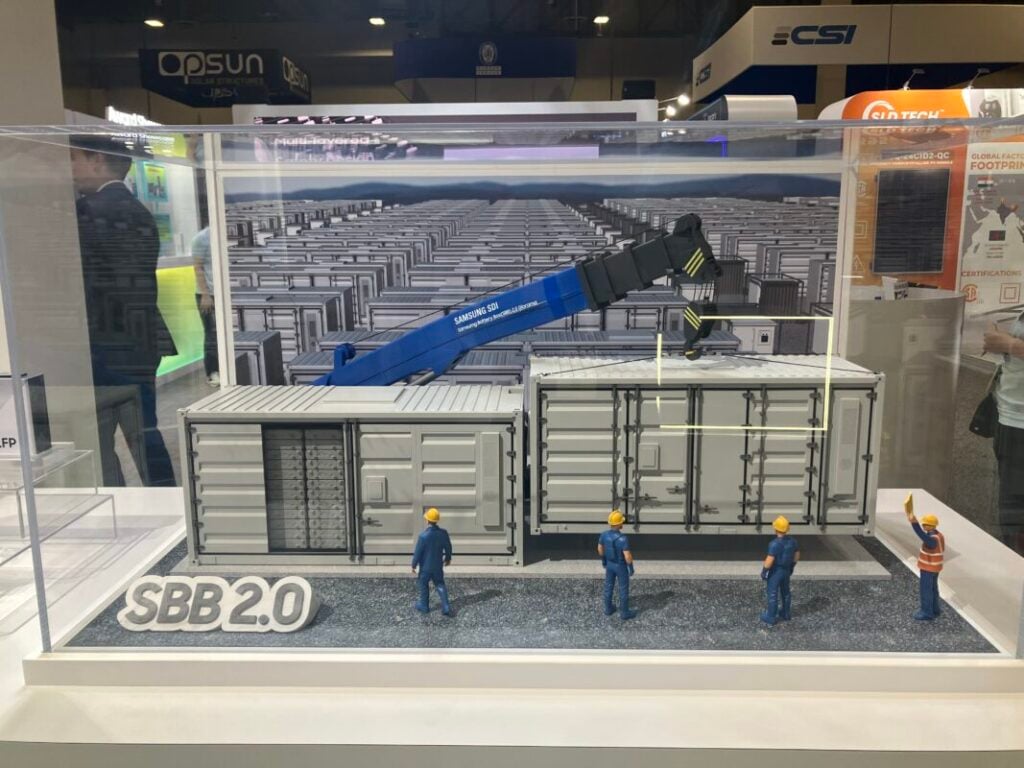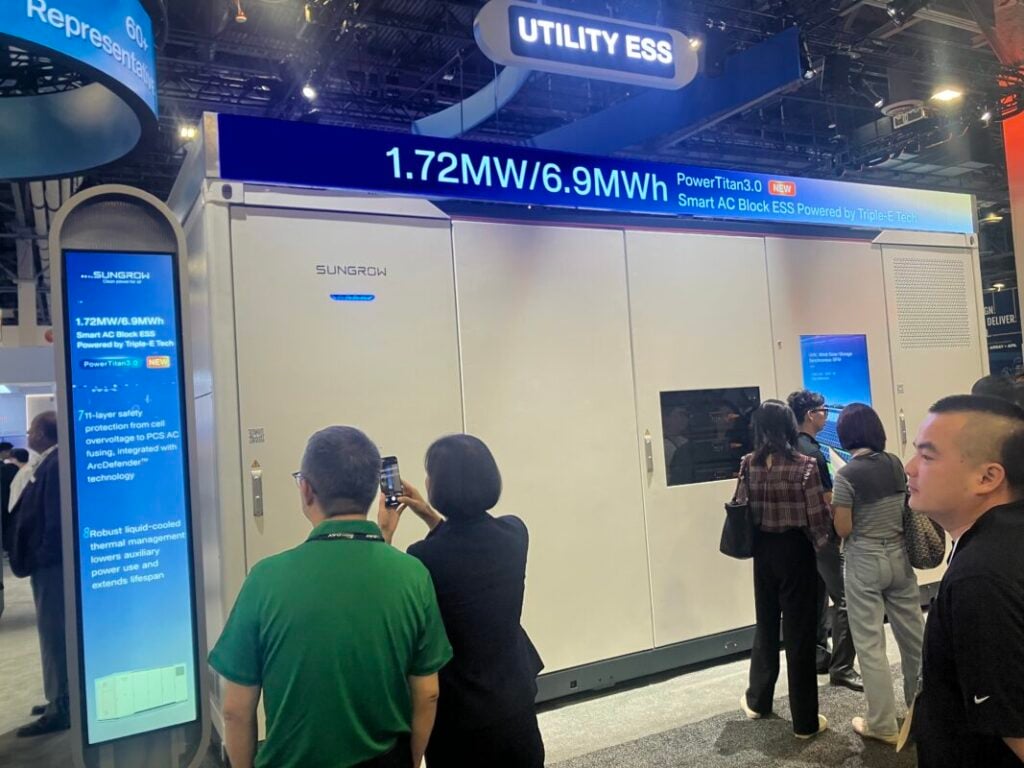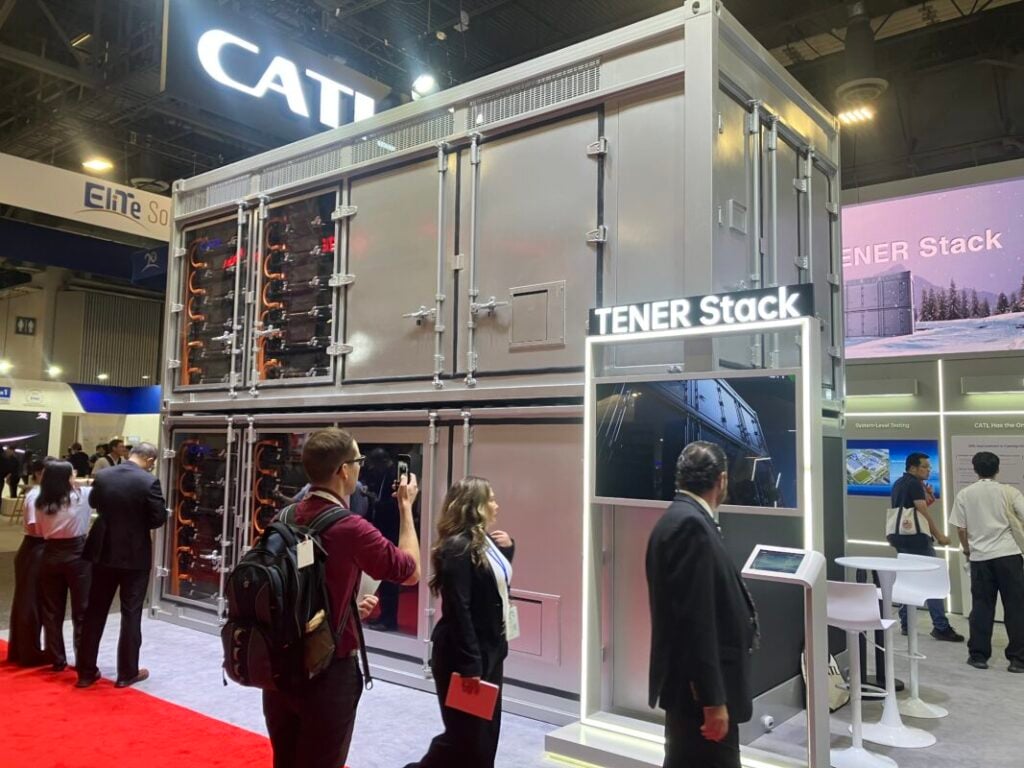‘Made in America’ and energy density race lead battery storage discussions at RE+ 2025

The conference sessions and expo hall at RE+ today sent a loud and clear message that the US market’s emphasis on US-made systems is in full effect.
“What we’ve been doing in the US is gradually trying to bring every piece of the solution into a US manufacturing facility so that we have the highest potential for qualification under domestic content,” Zahurancik says in an interview with Energy-Storage.news.
“So today, we can produce everything in the United States. That’s taken us a while to get the enclosure, the module, HVAC, cooling, racking, integration, everything.”
All this despite some ramping delays, which the company gave as the main reason for a recent US$100 million downgrade of its FY2025 revenue guidance, and were largely attributed to “typical” new factory issues by CEO Julian Nebreda in an earnings call.
“Anytime you start something new, you go through all of those bumps and learning curves of, did everybody order everything we were supposed to? Does everyone show up where they’re supposed to? Does somebody turn the drawing upside down? All of those kinds of things. We have a good quality process for catching those things, but you’ve got to come up a ramp curve,” Zahurancik says.
Fluence also just announced the start of production at its 35GWh BESS assembly plant in Vietnam to serve the rest of the world markets that comprise around half of the system integrator’s projects with its newest solution, SmartStack.
While Vietnam is considered a low-cost environment for high-tech manufacturing, tariffs and shipping costs rule out the possibility of that plant bolstering US supply, representing the other half of Fluence’s customer demand, the company’s Americas president says.
It appears every company with present or near-term capabilities of delivering battery energy storage system (BESS) solutions that meet domestic content requirements and navigate foreign entity of concern (FEOC) thresholds in the US ensures that the message is made visible through its exhibition floor presence at the show.
In Fluence’s case, BESS enclosures built in Arizona, battery modules produced in Utah, and HVAC and thermal management in Texas all come from the company’s own factories.
However, the tricky part, as Zahurancik admits, is cells. Cells comprise roughly half the cost of capex, and therefore, the biggest FEOC liability. About half of Fluence’s cell supply comes from a domestic source, AESC’s Tennessee factory, but around half still comes from Chinese suppliers.
On the other hand, Samsung SDI became the latest of the vertically integrated South Korean lithium-ion OEMs to announce US domestic BESS production at the show.
Two new products, including an 8.93MWh containerised LFP solution will become available in 2026 and 2027, with Samsung SDI following the lead of LG Energy Solution, which already started making LFP BESS cells at its Michigan plant, and SK On, which will start doing so at its facilities by the end of this year.
The South Korean players are leveraging two things: a head start through investments in electric vehicle (EV) battery lines, which can be retooled to produce cells for stationary applications.
For the rest of the market, it remains to be seen how quickly and at what sort of scale other capacity might come online, especially with greenfield LFP factories from startups like KORE Power and Freyr Battery and even established players like LG ES cancelled or on hold, and Chinese players seemingly ruled out of contributing significantly to the market, beyond a significant but time-limited safe harboured run of projects over the next two to three years.
From a tech trends perspective, the show floor’s abundance of BESS enclosures boasting capacities in excess of the 5MWh per standard 20ft ISO container form factor that only a year or so ago was setting a new benchmark for energy density was also striking.
One thing that makes it difficult to assess exactly where the benchmarks for energy density are moving to at a glance is that several newer solutions, such as Fluence’s SmartStack (6.25MWh) and CATL’s TenerStack (9MWh) and others, do away with the 20ft form factor.
Another obstruction to easy comparison is that, as is often the case with products teased at events, some are not yet widely available in the US or indeed have yet to enter mass production for any market.
Nonetheless, the trend is toward higher energy density from cell to system level, with large-format cells sized in excess of 600Ah and even, in the case of Hithium’s recent launch, 1000Ah, doing the heavy lifting.



Upping the energy density contributes to bringing down costs, says Brian Hayes, CEO of BESS developer, owner, and operator Key Capture Energy. Hayes adds that the developer is excited about this trend.
Of course, from there, the questions come about supply chain and where the cells are coming from, Hayes says, because of the essential role of cells at the heart of every system and ultimately, their high proportion of total capex cost.
Adam Bernardi, renewables development lead at engineering, procurement, and construction (EPC) firm Burns & McDonnell, picks up on the theme that apples-to-apples system comparisons are made trickier by the proliferation of non-standard form factors.
“I think eventually the market has to settle on a small number of densities for a few reasons, one of which being to effectively evaluate each product and give owners the option to seamlessly switch, or as seamlessly as possible,” Bernardi says.
As we have heard in previous articles on this topic from various sources, including Bernardi and his team, logistics and other factors must also be considered in the race for energy density increases.
“Shipping of the containers to the site and the lifting and setting activities will play a role in just how big and dense solutions can be. Another point to consider is the foundation sizing. While not a huge cost driver, the heavier the solution, the more steel and concrete are needed to support it [the units].”
“Then we get to insurability, which is probably closely tied to financeability. Insurers strongly consider the concept of maximum probable loss,” he says.
“So, the larger and denser the projects are, the higher the potential for a larger loss in terms of dollars and megawatts and therefore more risk.”
According to Bernardi those finance and insurance concerns likely outweight the physical concerns outlined. He says also that fire protection strategies and solutions for different sizes of enclosure “will be critical.”
“This is all about risk mitigation and balancing all of the factors.”
Still, Bernardi agrees with Key Capture Energy’s Brian Hayes that there are solid reasons to be excited about the energy density race.
Higher energy density, resulting in smaller project footprints, means lower construction costs, whereas it can also mean some project sites will become more feasible that were not when considering the use of less energy dense BESS containers, Bernardi says.
energy-storage





